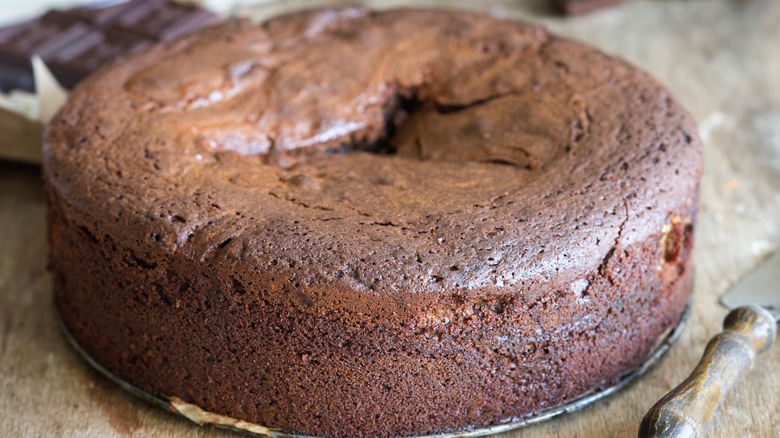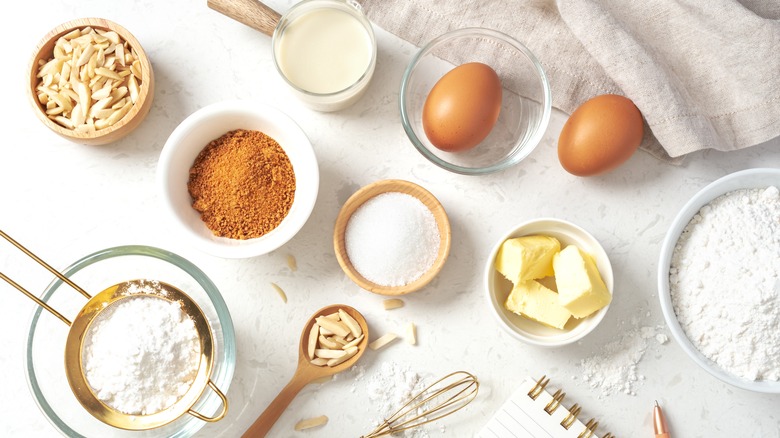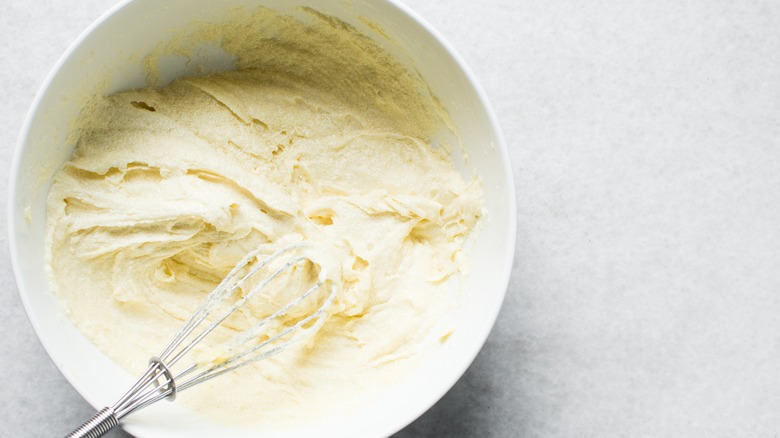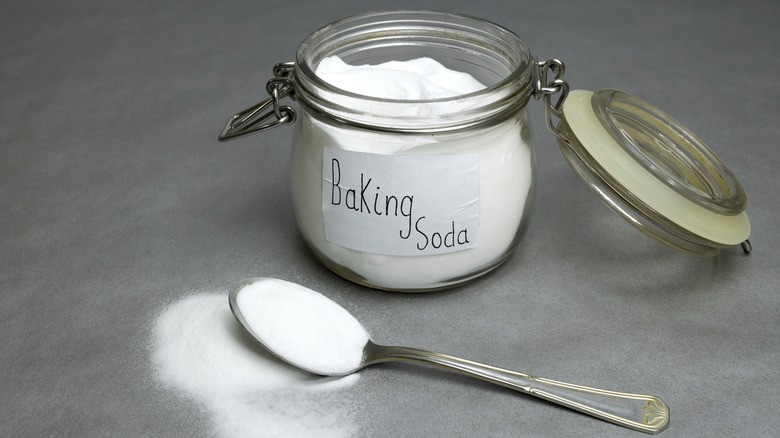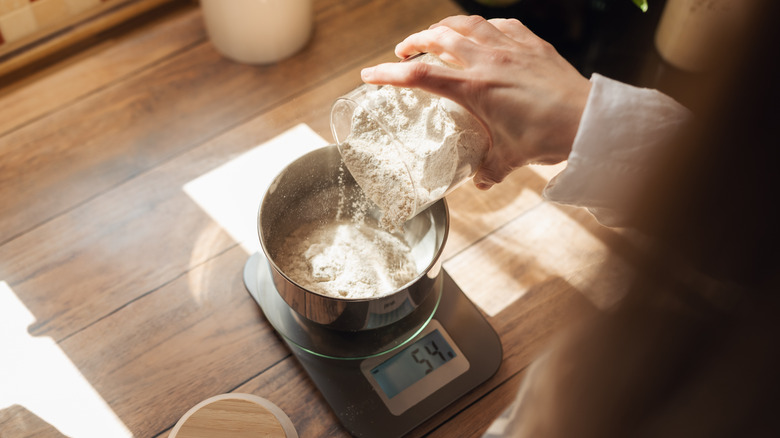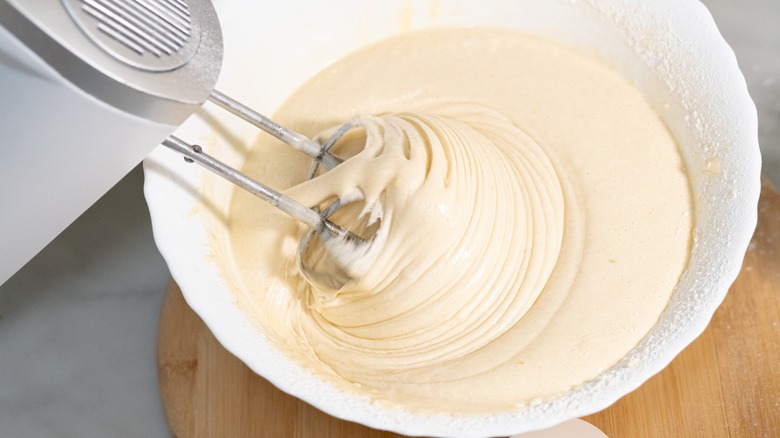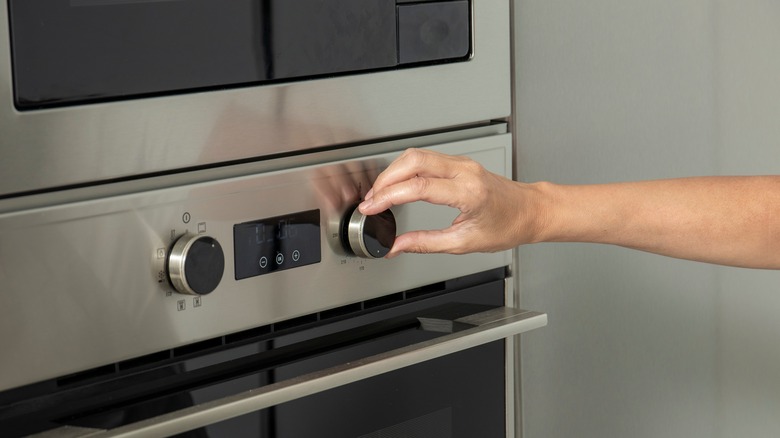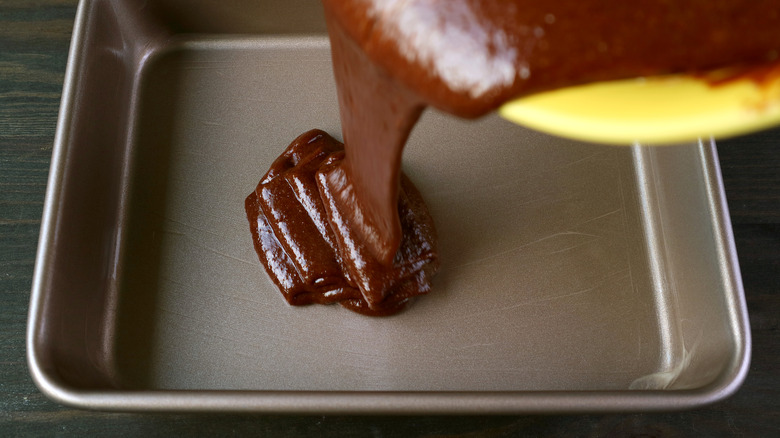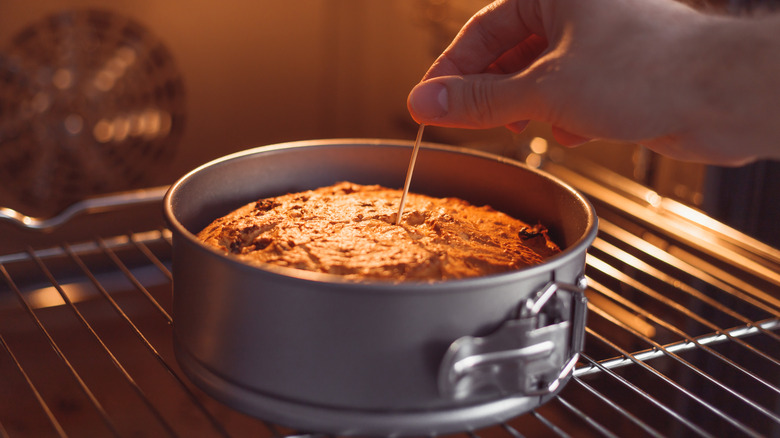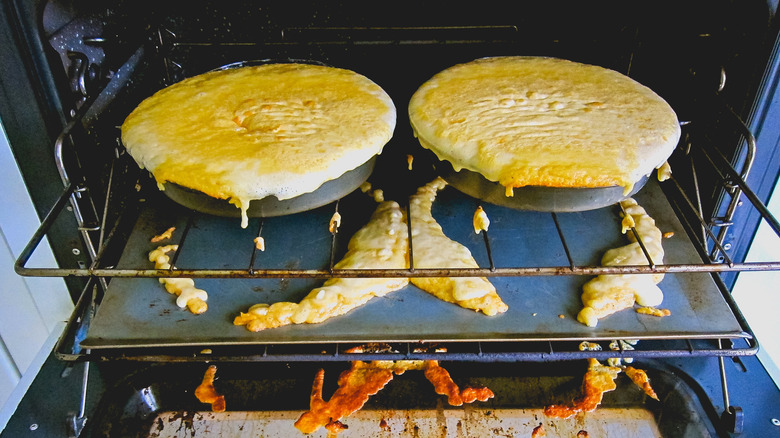What's Causing Your Cake To Sink In The Middle? An Expert Reveals The Mistakes You're Making
Cake is the focal point of many celebrations in our lives, from birthdays to weddings. There is nothing quite like a perfectly moist, rich cake made from scratch to put a smile on anyone's face. But, making a great cake is part science and part art, requiring some finesse to execute correctly. Whether you make it from a box or measure each ingredient yourself, you can run into many pitfalls along the way that can take your cake from festive to flop. Among these, one of the most disappointing dangers can be a cake that sinks in the middle as it bakes.
If you wonder why your cake does this, you have come to the right place. I have baked many cakes in my nearly 18 years as a professional chef. In that time, I have experienced every possible outcome, from the good to the bad to the ugly. I'm bringing my knowledge, experience, and expertise to you so that you can avoid making some simple mistakes that can deflate your cake (and your spirits) in one fell swoop. These secrets of the trade will help you produce a gargantuan gateau everytime you set foot into your kitchen.
Using the wrong ingredients
The ingredients are the single most important part of a cake recipe. Baking is a science, and recipes are carefully designed to work perfectly using precisely-measured, specific ingredients. If you make small changes in quantities, omissions, or additions of any kind, you can completely derail the recipe. Unlike cooking, which offers some leeway, you can't swap one ingredient for another with a cake recipe unless you have extensive experience as a baker. For this reason, one of the most basic mistakes you can make when baking a cake is failing to follow the recipe accurately. Ignoring this advice lead to a host of problems, including the cake sinking as it bakes.
I always recommend reading and then re-reading a recipe multiple times to confirm every ingredient. This allows you to prepare your mise en place before baking the cake. "Mise en place" is simply a fancy French term for putting everything in its place. In professional kitchens, this involves obtaining the correct ingredients in the right amounts, pre-measuring them, and laying them out in the order you will use them before you start baking. This is a great process to follow even in a home kitchen, especially if you are not an avid baker. It will prevent you from inadvertently using the incorrect ingredients, the wrong amounts, or forgetting to add something altogether.
Using ingredients that are too cold or too warm
If you have ever attempted to bake cookies that call for softened butter and forgot to remove it from the refrigerator before assembling them, you will understand the importance of using ingredients that are not too warm or cold. Like Goldilocks, you want them to be just right. Again, cake recipes are designed with precision in mind, and this extends to the temperature of the ingredients. Unless otherwise specified, ingredients for a cake should be at room temperature before you begin baking. Items like eggs, butter, and milk will be easier to emulsify at this temperature, resulting in a fluffier cake with a more tender crumb that will not deflate when you bake it.
For the purposes of baking, room temperature rests between 68 to 70 degrees Fahrenheit. If you do not have time to leave ingredients on the countertop for an hour, or are concerned about doing so for safety reasons, you can submerge them in warm water to help take the chill off. Once they are no longer cold to the touch, or the butter yields to the pressure of your finger, the ingredients are ready to be incorporated into your cake.
Lest you think hot ingredients aren't an issue, there is a major difference between melted and softened butter. Softened butter will help to incorporate air into the cake batter, causing it to rise in the oven. Melted butter will make your batter heavy, thereby resulting in the cake collapsing while it bakes.
Using the wrong kind or amount of leavener
Unlike yeast, chemical leaveners, such as baking soda and baking powder, enable baked goods to rise rapidly, shortening the time required to bake a cake and resulting in a lighter, airier product. That said, many individuals do not understand the difference between baking soda and powder – a crucial detail that will make or break a recipe. Baking soda, or sodium bicarbonate, expels carbon dioxide the moment it comes into contact with an acidic ingredient. Baking powder combines sodium bicarbonate with an acid, like cream of tartar, and a thickener, like cornstarch. This results in multiple reactions that help to leaven a cake, including the incorporation of a liquid and the exposure to heat, hence the term "double acting."
Most cakes use baking powder or soda (or both). Not measuring correctly, or swapping one leavener with the other, can result in your cake failing to rise properly. Other factors that may impact the efficacy of chemical leaveners is if they have expired or you happen to live at a high altitude (more on that later). Lastly, do not let your unbaked cake sit for too long after assembling it before you put it in the oven. As noted, baking powder is typically double acting, which means it requires heat to instigate the second rise. These actions must occur in rapid succession to be effective. Failing to put your cake in the oven immediately can halt the chemical process, causing your cake to sink when you bake it.
Measuring the ingredients inaccurately
Do you want to know the single best approach for guaranteeing your cakes come out perfectly? Use a scale to measure your ingredients. Measuring ingredients by weight instead of volume produces far more accurate results, as the method is less susceptible to inconsistencies between measuring cups and human error. This doesn't apply to dry ingredients alone; it is a crucial strategy for wet ingredients, too. Failure to accurately measure ingredients can result in a cake that is too dense, which can inhibit leavening and promote the dreaded collapse of the center of your masterpiece.
Always remember to zero out, or "tare," the scale to account for the weight of the mixing bowl or measuring container. Not doing so will result in incorrect measurements. While both are better than measuring by volume, a digital scale is easier to utilize and less vulnerable to human error than a mechanical or manual one. Of course, sometimes you can only work with what you have on hand.
If you insist on using measuring cups to put together your cake, you should always spoon rather than scoop the dry ingredients into them. Such an approach will reduce the likelihood of overpacking the ingredients, which can weigh down your cake batter. Once you have spooned in the ingredients, level them out with a knife before dumping them into your mixing bowl.
Overmixing or undermixing your cake batter
Mixing is simply the process of combining all of the ingredients, right? Wrong. Whisking, stirring, beating, folding — each of these techniques for incorporating ingredients into one another yields dramatically different results and accomplishes distinct goals. Failing to use the correct technique can result in overmixing or undermixing the cake batter, which will directly influence the texture of your cake. Overmixing your cake batter can make it dense, which will inhibit it from rising properly, making it look deflated in the middle. Undermixing can fail to incorporate enough air into the batter, which will also prevent the cake from rising properly, resulting in a sunken, sad looking cake.
To determine if you have overmixed or undermixed your cake batter before you put it in the oven, look for some telltale signs. Each recipe will specify the proper technique and duration to use to mix your cake batter. Follow these to the letter. They have been tested and included for a reason. There are also generally visual cues, like "until just combined" or "until stiff peaks are formed," that you can use to guide your approach. Most cake recipes are intended to be mixed until there are no longer obvious streaks of flour present, but not until the batter begins to feel thick or air bubbles have disintegrated. Do not get distracted during this crucial stage of the cake baking process.
Failing to preheat your oven
Preheating the oven to a specific temperature is one of the first instructions listed on a recipe for baking a cake. While this may not seem like a make or break step, it can mean the difference between a perfectly baked cake and one with an underdone center. Indeed, heat is essential to triggering the leavening mechanisms of baking powder. If you do not place your cake batter into a preheated oven immediately after you have assembled it, the cake will cease to rise.
I have baked with both gas and electric ovens, and neither has ever actually registered the correct temperature when I tested it with an oven thermometer. For this reason, it is crucial to periodically check your oven's temperature so you can adjust it as needed. For example, if your oven says it is set at 325 degrees Fahrenheit, but a thermometer registers at 300 degrees Fahrenheit, you will want to raise the temperature by 25 degrees to obtain the correct baking temperature. Conversely, if the oven registers as hotter than the temperature at which you set it, you may need to lower it. Lastly, it is critical to know your oven's hot spots: areas where the heat reaches more intense levels. Rotating your cake to accommodate these hot spots will save you a lot of anguish over a deflated or burnt end product.
Using the incorrect pan size or shape
Another factor that can adversely impact your cake resulting in a saggy center is swapping the size or shape of the pan indicated in the recipe. Recipes are designed to use specific pans based on the final shape of the cake, the density of the batter, and the desired texture. Even pans that appear similar in shape, like a bundt or tube pan, can be vastly different when it comes to something as precise as baking a cake.
Most baking pans are made from metal, glass, or ceramic; however, silicone variations are also available. While these may look nicer, beware of swapping them for metal and expecting similar results from a pan that is otherwise identical in size or shape. Metal is far more efficient at conducting heat and can bake more consistently. It also allows for a more distinctly shaped cake that is easier to frost and decorate.
The color of your metal pan is also something to consider. A lighter-colored pan that is grayish or silverish in hue will bake more evenly. Dark metal pans can result in charred edges or a cake top that is burnt yet raw and sunken in the middle. The bottom line: if you want to guarantee a perfect cake, stick to the recipe, otherwise you need to be extremely adept at math to scale a recipe based on the volume of a pan of another size or shape.
Opening the oven door too much
Many of us fall prey to a habit that we don't realize is ruining our cakes: checking on them over and over again. Remember how you pre-heated the oven ahead of time so that it would be ready for your cake at the correct temperature, helping it to rise properly and bake evenly? Every time you open the door and peek into the oven to monitor the baking cake, you allow all of that precious heat to escape. This means that the oven has to return to the correct temperature before the cake can resume baking, which takes time and can result in a deflated gateau.
The only time you should open and close the door is if you need to rotate the cake due to hot spots in your oven. This may occur once during the baking process, usually half to two-thirds of the way into the total bake time. Open and close the door rapidly, and be careful not to slam the door it you shut it. This shock can rupture the developing air bubbles in your cake, causing it to sink. Set a timer and use the window in your oven to keep an eye on your cake. If you do not have a window, trust yourself and your oven and begin checking your cake for doneness about 10 minutes prior to the designated baking time indicated on the recipe.
Underbaking the cake
Underbaking a cake may result in your creation sinking in the middle. A cake may look perfectly golden brown when it reaches the designated baking time, but the center may still be raw. Unfortunately, all ovens differ, making baking times a suggestion, more than a hard and fast rule. A cake should reach between 205 and 210 degrees Fahrenheit to be considered fully baked.
While you can use a thermometer to measure this, I suggest inserting a toothpick into the center of the cake to see if it comes out clean before removing it from the oven. Another good way to determine doneness is to touch the top of the cake. It should feel set, not gooey. Lastly, the cake will contract as it bakes, pulling away from the edges of the baking pan. If you notice that a cake is beginning to burn on top, but the center is still underdone, cover it with aluminum foil until it has completely set before removing it from the oven.
If you remove an underdone cake from the oven, you can salvage it. If the cake is uniformly underdone, return it to the oven to finish baking. If just the center is underbaked, you may want to cover it with aluminum foil before putting it back into the oven. Either way, you may notice some diminishment in overall texture and height of the finished cake, but it will still be safe to eat.
Extreme weather or high altitude
Extreme weather and high altitude can completely derail a cake recipe, even if you follow it to a tee. Changes in weather are notorious for impacting how (or if) a cake rises properly. If it is too hot or too cold, ingredients may not emulsify well, forming inconsistent air bubbles, which can cause your beautiful cake to cave in on itself in the oven. Excess humidity can also impact your cake by causing certain ingredients to weigh more, particularly if they are improperly stored. This can throw off your measurements, resulting in a dense cake. For this reason, it is important to know the temperature of your kitchen at all times. If you can control the temperature and humidity and keep it steady year-round by using a heater, air conditioner, or dehumidifier, you will have more consistent results.
When it comes to high altitudes, most recipes will require adjusting to turn out accurately. Anything over 4,000 feet above sea level can make a big difference in the final cake. The increased elevation can cause cakes to rise faster, but it may also result in dehydration as they bake. You can take these aspects into account by lowering the amount of leavener you use and adding more moisture to the batter, though I recommend using recipes that have already been adjusted for high elevations. This will take any guesswork out of the baking process or the need for trial and error.
